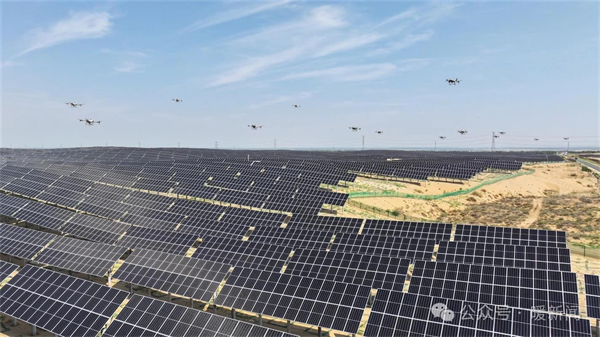Recently, a demonstration of mechanical operation between solar panels was carried out in the Kubuqi Desert in Dalad Banner, Ordos. Five new-type robots designed to carry out comprehensive desert treatment operated simultaneously. It took the robots just two minutes to plant a 30-meter-long row of Salix mongolica seedlings. They first loosened the soil before transplanting and fixing the seedlings, covering their roots with soil, and watering them.
Gao Jianzhong, vice general manager of Inner Mongolia Jintaiming Technology Group, stated that, previously relying on manual labor, a worker can only cover 3 mu (0.2 hectare) of land in a day and it costs 300 yuan ($42.36). Now, by controlling five machines, a worker can cover 400 mu of land in the same time, while increasing the survival rate of seedlings to about 90 percent.

Robots operate between the solar panels. [Photo/WeChat account of Nuan news]
The robots integrate multiple technologies, including spiral drilling, self-driving, and artificial intelligence. The robots, which feature independent Chinese Intellectual Property Rights, can work without human control on a large scale and in all types of weather, improving efficiency by nearly 40-fold compared to manual labor. Other types of desertification control equipment have also been put into use, including command vehicles for joint operation of the robots, as well as semi-automatic planting vehicles.
The company has also adjusted its equipment operation model to fit the working environment between solar panels. "To avoid damaging the cables beneath, we have upgraded equipment and adjusted the planting depth from 80 centimeters to 30-40 cm, leading to a higher survival rate," Gao added.
At the same time, 20 drones sowed Hedysarum mongolicum and scoparium from the air, making for a truly eye-catching scene! With the emergence rate improved by nearly 15 percent, nearly half of the seeds could be saved, lowering costs and increasing efficiency.

Aerial sowing drones hover above the panels. [Photo/WeChat account of Nuan news]
"Efficiency is nearly 100 times higher than if relying on manual labor, and 10 times compared to non-intelligent machines, reducing costs by 15 yuan per mu," said Guo Jing, head of the Operations Department of Ordos Kaitu Technology Co.
Over the years, Ordos has been dedicated to the integrated conservation and restoration of mountains, rivers, forests, farmlands, lakes, grasslands, and deserts, mobilizing all resources at its disposal to prevent and control desertification as well as restore the environment.
With cutting-edge technologies being applied to tree planting and forest preservation, Ordos has been striving for high-quality comprehensive prevention and control of desertification supported by new technologies, equipment, processes and models, thereby providing intelligent and efficient solutions to the environment conservation campaign along the great bend of the Yellow River, as well as the integration of desertification prevention and control with wind and photovoltaic power.
"We have tried various high-tech methods for desertification prevention and control, achieving strong results. Now we are testing drone aerial sowing and robot planting between solar panels, and such methods will be promoted to all photovoltaic bases in the city, if the desired results are achieved," said Liu Shanghua, deputy director of the Ordos Forestry and Grassland Science Research Institute.